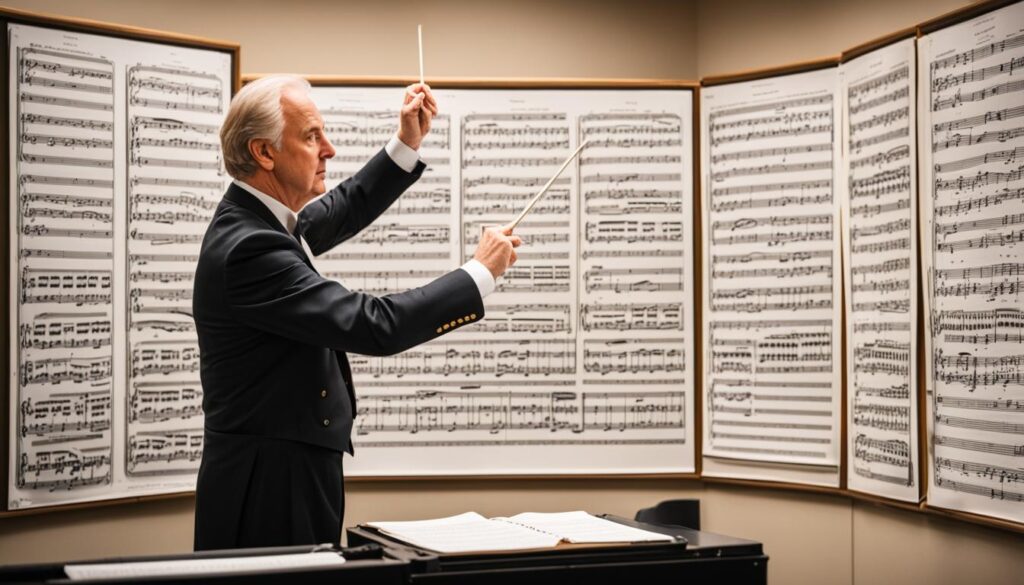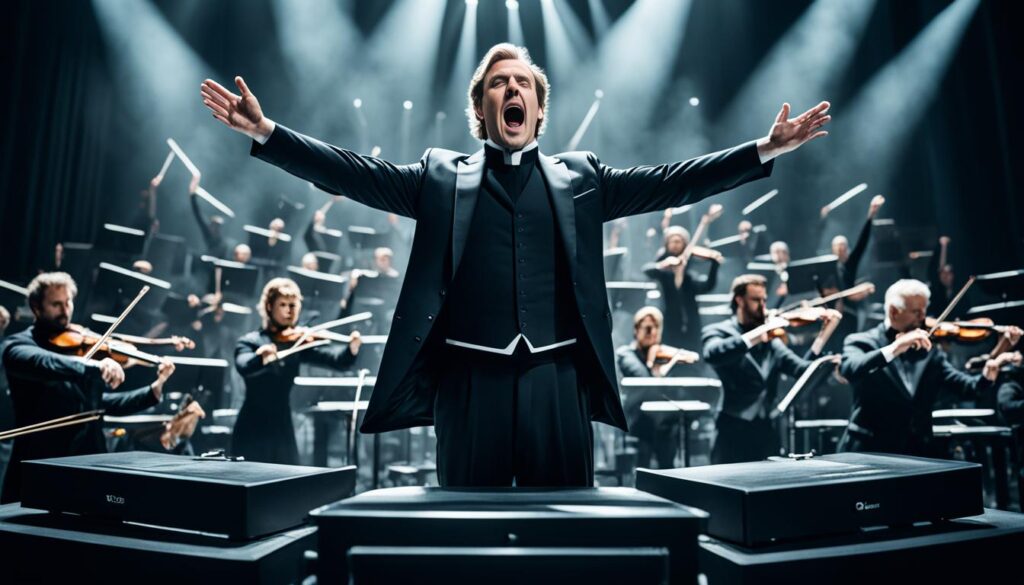As a conductor, I’ve tackled many challenges. None, however, are as tough as leading the brutal orchestra. This orchestra plays avant-garde music, which is very different from traditional works. It uses new sounds, instruments, and ways of playing.
Take, for example, Béla Bartók’s piece, The Wonderful Mandarin. This music is stark, with a modern edge, telling a dark story. Rudolf Kempe brings this to life with sharp details, showing the piece’s cold, violent heart through its harsh sounds. The music evokes a world of pimps, brutal acts, and a doomed man from China.
Table of Contents
The Challenges of Conducting a Brutal Orchestra
Conducting a brutal orchestra for pieces like Béla Bartók’s The Wonderful Mandarin brings novel tests. The music’s nature is unyielding and its sound fierce and modern. This calls for a level of skill that usual conductors might not have needed before.
Understanding the Unique Demands of Avant-Garde Compositions
Avant-garde pieces, such as The Wonderful Mandarin, are known for their complex rhythms and unusual harmonies. They also use techniques that are not often seen in traditional music. Leading a group through these works takes deep knowledge and the conductor’s ability to share the composer’s vision.
Adapting to the Unconventional Instrumentation and Extended Techniques
Another big challenge is getting used to the different instruments and playing methods. Bartók uses a lot of percussion and unique ways of playing strings and woodwinds in The Wonderful Mandarin. The conductor needs to know all about these and help the players perform them well.
Overcoming the Resistance of Musicians to Unfamiliar Styles
Orchestral musicians often don’t feel at ease with non-traditional music. They might find avant-garde pieces tough. The conductor’s job is to help them see the value in these works and to work well together.
| Challenge | Conductor’s Approach |
|---|---|
| Complex rhythmic structures | Meticulously study scores and develop clear, precise conducting gestures |
| Unconventional instrumentation | Familiarize oneself with extended techniques and guide musicians through their execution |
| Resistance to unfamiliar styles | Build trust, foster collaboration, and encourage musicians to embrace challenges |
Overall, conducting such orchestras is a mix of music knowledge and people skills. By understanding, adapting, and encouraging, a conductor can unravel these works’ true power. This can make a mark, not only on the audience but on the musical scene as a whole.
Preparing for the Brutal Orchestra: A Conductor’s Journey
Conducting a brutal orchestra takes careful planning and a solid grasp of their advanced music. As a conductor, I’ve learned that you need to study the scores well, have excellent rehearsal plans, and earn the trust of your players. These are key to handling the difficult pieces.
Studying Scores and Analyzing Complex Rhythmic Structures
The first step is to dive deep into the score. I spend hours understanding its complex rhythms and notations. This includes figuring out what the composer wanted and looking at how the different parts should work together. I also spot any potential problems for the musicians.

Developing Effective Rehearsal Strategies for Challenging Works
Understanding the score, I work on smart rehearsal plans. I break tough parts into smaller bits to focus on details and accuracy. Slowly, we work up to the right speed and power. Communicating clearly, using gestures, and specific exercises really help the players understand and play such challenging pieces.
| Rehearsal Strategy | Description | Benefits |
|---|---|---|
| Sectional rehearsals | Working with individual sections to address specific challenges | Allows for focused attention on technical difficulties and fosters cohesion within sections |
| Slow practice | Rehearsing passages at a reduced tempo to ensure accuracy and clarity | Helps musicians internalize complex rhythms and unconventional techniques |
| Gradual tempo increases | Incrementally increasing the tempo during rehearsals | Allows the ensemble to build confidence and maintain precision as they approach the final tempo |
Building Trust and Rapport with the Ensemble
More than just tech prep, I find it vital to build trust with my players. They need to feel supported and encouraged. I focus on open talks, listening to their worries, and giving helpful feedback for their growth. By doing this, the team can face the hard pieces together well.
“Conducting a brutal orchestra requires not only technical mastery but also the ability to inspire and guide musicians through uncharted territory. It is a journey of discovery, trust, and unwavering commitment to the music.”
Preparing to lead a brutal orchestra involves a lot: hard work, skill, and a love for music. Through detailed study, smart rehearsal plans, and strong bonds with the players, conductors can bring avant-garde pieces to life. This creates profound musical moments for everyone involved.
The Role of the Conductor in Shaping the Brutal Orchestra’s Sound
Being a maestro in a brutal orchestra is a big job. I shape the sound to match the composer’s intent. This means using a precise ear, hand movements, and deep focus on tricky avant-garde music. It’s a tough job, but the result is worth it.

Balancing the Competing Timbres and Dynamics of the Ensemble
Finding the perfect orchestral balance is key. I make sure each part of the orchestra is just right. In pieces like Bartók’s The Wonderful Mandarin, the mix of sounds and loudness can be a lot. I work hard to keep the music together so every part can be heard.
I manage rough sounds, odd patterns, and deep tones. Yet, I keep the music as one, letting every tune be clear.
Sculpting the Phrasing and Articulation to Convey the Composer’s Intent
I also shape the musical lines so they tell the composer’s story. Take The Wonderful Mandarin, for example. Rudolf Kempe’s version shows how a conductor can bring out the work’s harshness and cruel force. I shape every phrase and rhythm with care.
This way, the music doesn’t just play. It speaks loud and clear, even in the most challenging pieces.
Conducting a brutal orchestra is intense. It’s knowing the music deeply, staying true to what the composer wanted, and guiding musicians bravely.
Leading in the brutal orchestra is both challenging and rewarding. It lets me uncover the deep power and beauty in complex music. By focusing on my role, I hope to open the doors to avant-garde music’s true value for people everywhere.
Navigating the Politics and Personalities of the Brutal Orchestra
Leading a brutal orchestra is about more than just music. It’s also about handling complex orchestra politics and the different personalities of the musicians. Sometimes, trying new things in music can be tough. Musicians might not like something new or different. A good conductor handles this by leading with strength, working together, and solving problems. This makes the whole group work well together.
In Cincinnati, Michael Gielen faced a tough crowd at first. Some musicians didn’t like his direct style or his unique music choices. But, his powerful performances and deep love for music won the audience over. Even if not everyone in the orchestra agreed. This shows how important it is to be firm yet build positive relationships while dealing with orchestra politics and diverse personalities.
Later, Gielen started working with the SWR Orchestra in a more team-focused way. He listened to the musicians’ ideas and respected their work. This created a strong bond and respect within the group. This change in how he led proved that working together and being flexible is key in a tough situation.
“I have come to believe that the key to succeeding as a conductor of avant-garde works lies not only in one’s musical prowess but also in the ability to unite the orchestra through empathy, open-mindedness, and a shared passion for pushing the boundaries of what is possible.”
From my own experience, building strong bonds with each musician really matters. Understanding what they care about and finding common interests helps a lot. This approach with kindness, strength, and listening can solve many problems and make the group feel together. Musicians work better when they feel respected and supported.
To manage the brutal orchestra, conductors need to be both strong and kind. They must balance their vision with teamwork. With this approach, they can solve problems and unite the group. Then, they can create amazing music, even from the most challenging compositions.
Conclusion: The Rewards of Mastering the Brutal Orchestra
Learning to lead the brutal orchestra is both tough and rewarding. A conductor must know complex music, work with unique instruments, and handle ensemble dynamics. Despite these challenges, the experience brings unmatched personal and professional growth. Successful conductors change the way people see and hear music.
For example, consider Michael Gielen, known for his work in all types of music. He pushed the limits of what orchestras could do and found new meanings in old pieces. This has made him a legendary figure in the conducting world. His story shows the great things conductors can achieve in this field.
Those who master the brutal orchestra do more than just grow as artists. They push music forward, engaging and inspiring everyone with their bold ideas and musical experiments. This path is not easy, but the impact and growth it brings is truly remarkable. It’s a journey full of challenges, but the rewards in music and audience connection make it all worthwhile.










